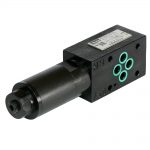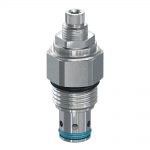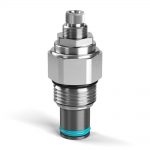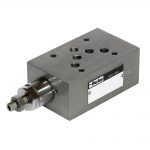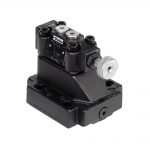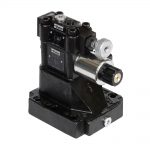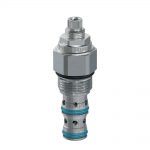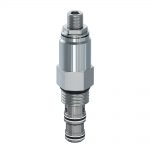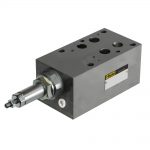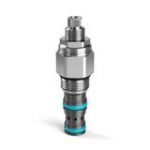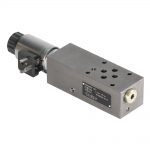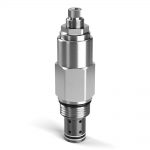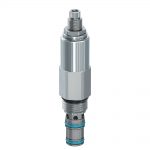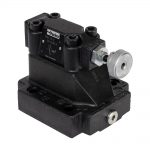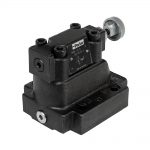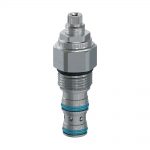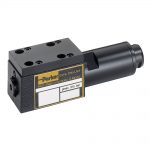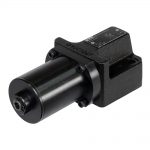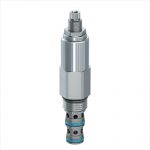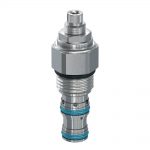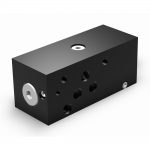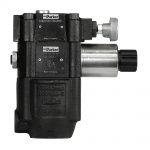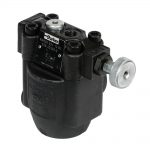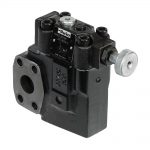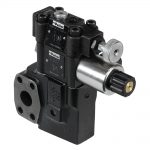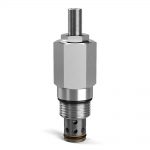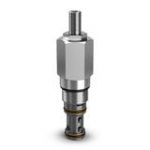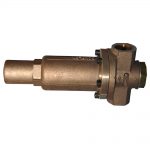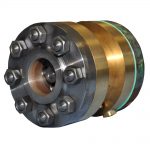HYDRAULIC PRESSURE CONTROL VALVES
HYDRAULIC PRESSURE CONTROL VALVES
Parker offers hydraulic needle valves for speed controls on hydraulic and pneumatic systems where a reverse flow check is not needed. They provide excellent control and a reliable shutoff in a very small envelope. A two-step needle allows fine adjustment at low flow by using the first three turns of the adjusting knob. The next three turns open the valve to full flow, and also provide standard throttling adjustments.
HYDRAULIC PRESSURE CONTROL VALVES INCLUDE
Parker direct operated pressure reducing valves series PRDM in sandwich design ensure a precise pressure regulation in one area of a hydraulic circuit at a predetermined level below normal system pressure.
As a mature component of Parker’s modular sandwich valve system, the direct operated pressure reducing valves series PRDM feature fast response and minimum hysteresis for continuous high productivity. They regulate pressure in one area of a hydraulic circuit at a predetermined level below normal system pressure. Additionally, an integral pressure relieving function for the secondary reduced pressure circuit is incorporated into the design.
Markets:
• Industrial
• Machine tools
• Rubber & tire processing
Features/Benefits:
• Extremely versatile due to a wide pressure range
• Fine-tuned pressure stages – tailor-made for precise pressure regulation
• Fast response – ensures optimized operation
• Direct operated, cushioned piston design – provides low leakage and minimum hysteresis
• Short delivery time for most variations – no warehousing necessary
• Sizes: PRDM2 – NG06 (CETOP 03), PRDM3 – NG10 (CETOP 05)
• 3-way design for pressure relieving of the secondary side
• Reduced pressure in the ‘P’, ‘A’ or ‘B’ port
• Pressure settings: 25, 70, 160, 210, 350 bar for PRDM2; 19, 50, 100, 150, 210 bar for PRDM3
• Gauge port
Applications:
• Suitable for general hydraulic applications
• Machine tools
• Tire presses
Function:
PRDM valves are “normally open” devices that allow fluid to flow through the controlled port during their non-actuated or “at rest” condition. When downstream pressure exceeds the value set by the spring force, the control piston moves off its seat, closing off the flow path and thus reducing the fluid passing through from the main system. The cushioned piston modulates to maintain the preset pressure in this branch of the hydraulic circuit. If, due to external forces, the pressure continues to rise in this branch circuit, the piston will keep moving against the spring force allowing fluid to be drained to the tank, thereby limiting maximum pressure to the valve’s setting.
Parker’s pilot operated relief valves are designed for continuous duty applications featuring great stability with low pressure drop; working with pressures up to 420 bar (6000 psi) and flows up to 400 lpm (106 gpm).
Parker’s pilot operated relief valves provide a stable design with low pressure drop meant for continuous duty applications while operating with less hydraulic noise. These valves can work with pressures up to 420 bar (6000 psi) and flows up to 400 lpm (106 gpm) in a reliable and compact design. Parker’s pilot operated relief valves are ideal for limiting system pressure or in standard relief valve applications within mobile and industrial equipment such as agricultural, aerial, refuse, industrial power unit systems, mining equipment, and other heavy duty fluid power pressure control circuits.
Markets:
• Miscellaneous Industrial
• Miscellaneous Manufacturing
• Miscellaneous Mobile
Features/Benefits:
• High pressure and flow capacity
• Low leak ball and poppet designs
• Compact design
• Internal screens
• Hardened, precision ground parts for durability
• All external parts zinc plated
Applications:
• System pressure limiter
• Port/cross-port relief
• Swing relief
• Motor braking
Additional Technical Insight:
This family of valves is best suited for continuous duty systems where the valve is asked to operate beyond any intermittent use. They can be used to maintain system pressure for long periods of time. Additionally, where systems may have large rates of change in flow, the pilot operated valves can accommodate these changes without excessive pressure rise or sometimes called pressure override. Due to the flow opening areas through the valve, these spool type valves will operate more quietly than a conventional direct acting valve. One must also consider the leakage component as the spool is, by design, going to pass a small leakage flow, whereas a direct acting valve does not pass significant flow until the cracking pressure is reached. Spool type relief valves should not be used in load holding application.
Parker’s direct acting relief valves are available in several cavity sizes and are designed for continuous duty applications with pressures up to 420 bar (6000 psi) and flows up to 200 lpm (53 gpm).
Parker’s selection of direct acting relief valves are fast acting and designed for continuous duty applications with pressures up to 420 bar (6000 psi) and flows up to 200 lpm (53 gpm) in a variety cavity sizes. The variety of pressure adjustment styles available makes these valves an economical solution for clipping pressure spikes and can handle up to full system flow if needed. Poppet style direct acting valves have low leak conditioned seats and are ideal port reliefs in cylinder control applications. Parker’s small, low flow, direct acting valves perform well when controlling pilot circuits or limiting load sense pressure.
Markets:
• Miscellaneous Industrial
• Miscellaneous Manufacturing
• Miscellaneous Mobile
Features/Benefits:
• Hardened, precision ground parts for durability
• Compact size for reduced space requirements
• Low leakage design poppet design available
• Fast response
• All external parts zinc plated
• High pressure (6000 psi) product available in some models
• Adjustable, fixed, or tamper resistant adjustments available
• Multiple spring ranges are available
• All valves are 100 % tested
Applications:
• Port/cross-port relief
• System relief
• Pilot and/or load sense relief
• Braking
Additional Technical Insight:
Full flow direct acting relief valves can be used as a main system relief valves in low flow circuits. Direct acting valves are fast acting, therefore, these devices and can be an economical solution for clipping pressure spikes. Poppet style direct acting valves have low leak conditioned seats and are often used as a port relief in a cylinder control applications. Small, low flow, direct acting valves are ideal for controlling pilot circuits or limiting load sense pressure.
Parker’s pilot operated pressure reducing valves series ZDR in sandwich design provide maximum flow rates up to 120l/min and enable an easy configuration of stack systems.
The proven pilot operated pressure reducing valves series ZDR represent Parker’s experience in high-performance components for stack systems. Designed for maximum flow rates up to 120 l/min, these sandwich valves in NG06 (CETOP 03) and NG10 (CETOP 05) offer best conditions for reliable operation.
The reducing function can be located in the ports P, A or B. The sizes NG06 and NG10 are equipped with an integral return flow check valve (reducing function in A or B).
Markets:
• Industrial
• Machine tools
Features/Benefits:
• Compact, proven design that represents our long-term experience in hydraulics – increases reliability
• High flow capacity – optimum efficiency in relation to valve size
• Short delivery time – no warehousing necessary
• Available in two sizes:
ZDR01 – NG06 (CETOP 03)
ZDR02 – NG10 (CETOP 05)
• Pressure function in P, A or B
• With integral return flow check valve
Applications:
• Suitable for general hydraulic applications
• Machine tools
Parker subplate mounted pilot operated pressure reducing valves series R4R ensure a constant pressure in the secondary part of the hydraulic system. Series R4R*P2 enables a continuous adjustment by the proportional solenoid operated pilot stage.
As versatile pilot operated pressure reducing valves for subplate mounting, Parker’s series R4R with manual adjustment and series R4R*P2 with proportional solenoid adjustment provide high flow and ensure a constant pressure in the secondary part of the hydraulic system. Independent of the primary pressure, the secondary pressure is reduced to the pressure setting. In order to avoid unintended motion of the actuator, the valves are normally closed.
Series R4R*P2 has additionally a proportional solenoid operated pilot stage and a cartridge main stage. The optimum performance can be achieved in combination with the digital amplifier module PCD00A-400.
Markets:
• Industrial
Features /Benefits:
• Wide range of options – suitable for almost every application
• Flexible, versatile mounting in any orientation – makes integration easy
• Normally closed position – avoids unintended actuator motion
• High flow up to 500 l/min in NG32 – optimum efficiency in relation to valve size
• Short delivery time – no warehousing necessary
• Subplate mounting according to ISO 5781
• 3 pressure stages: 105, 210, 350 bar
• R4R*P2: optimally suited to the digital amplifier module PCD00A-400
Applications:
• Suitable for general hydraulic applications
Parker’s pilot operated acting reducing & relieving valves are used in applications where specific functions require reduced and regulated pressure. Capable of flows up to 150 lpm (40 gpm) and pressures up to 380 bar (5500 psi).
Parker’s family of pilot operated acting reducing & relieving valves provide superior pressure control in applications where specific regulated and relief pressures are needed for precise operation on functions that require regulated pressures up to 380 bar (5500 psi) and flows up to 150 lpm (40 gpm). Parker’s pilot operated acting reducing & relieving valves are designed with several pressure ranges in order to give a higher degree of control with a variety of adjustment style options available. The additional valve stability due to the pilot operation make these valves ideal for sensitive functions such as up or downforce, clamping, or braking applications on various types of machinery within the mobile and industrial markets.
Markets:
• Agriculture
• Construction Equipment
• Industrial
• Miscellaneous Manufacturing
• Miscellaneous Mobile
Features/Benefits:
• Multiple pressure ranges available for more accurate pressure control
• Compact size for reduced space requirements
• Adjustable and tamperproof versions available
• High pressure capacity
• All external parts zinc plated
Applications:
• Brakes
• Clamps
• Suspension systems
• Up/down-force systems
Additional Technical Insight:
Typical applications are in mobile & industrial equipment, where a branch of the system is intended to operate at a lower setting than high system pressure. Hydraulic functions such as brake circuits, clamping or clutch circuits, suspension systems, street sweepers, or seeding and planting rows in agricultural equipment are common applications for these products.
Proportional pressure reducing valves series VMY in size NG10 and NG16 allow the variable adjustment of the reduced pressure from 0 bar up to the nominal pressure.
Working extremely precise, Parker’s proportional pressure reducing valves of the series VMY in size NG10 or NG16 improve the process accuracy of hydraulic applications. They provide a variable adjustment of the reduced pressure from 0 bar up to the nominal pressure.
The valve consists of a spool type main stage and a proportionally operated pilot stage. The desired pressure can be variably set corresponding to the command signal specified on the amplifier. The proportional solenoid converts the current of the amplifier into force on the valve poppet of the pilot stage.
Typical applications are pressure systems, test equipment, or counterweight systems. The optimum performance can be achieved in combination with the digital amplifier module PCD00A-400 for open loop systems or with PWDXXA-40* for closed loop systems.
Markets:
• Industrial
• Machine tools
Features/Benefits:
• Works very precise – for high process accuracy
• High oscillation stability – preserves the material and improves the product quality
• 5 pressure stages – enables fine adjustment
• Short delivery time for most variations – no warehousing necessary
Applications:
• Suitable for general hydraulic applications
• Machine tools
Function VMY*K06:
With the proportional solenoids de-energized, the main spring forces the main spool into the neutral position. Port A is connected to port T. Thus the reduced pressure only depends on the back pressure in the external drain pipe and/or the tank pressure and can accordingly be reduced down to 0 bar. The pressure present in the P line delivers the pilot oil to the pilot stage via a flow control valve.
When the proportional solenoid is energized, the pilot pressure is increased in the pilot pressure area, and the main spool moves against the spring until the connection P – A opens. The regulation of the reduced pressure on connection A takes place by the constant comparison of the actual pressure and the reference pressure of the pilot stage.
Function VMY*K10:
The valve spool is designed so that the connection B-A is open in the neutral position and is closed in the working position.
Parker’s unloading pressure control valves automatically charge and maintain a specific pressure range within accumulators by loading and unloading pump flow. Usable with fixed or variable pumps and pressure of 420 bar (6000 psi) and flow up to 1 gpm.
Parker’s robust and reliable unloading pressure control valves provide superior accumulator charge control by automatically charging up to the maximum setting and recharging once the minimum pressure setting is reached. These valves are capable of handling flows up to 3.75 lpm (1 gpm) and pressures as high as 420 bar (6000 psi). Internally or externally piloted options are available and are ideal for unloading pump pressure and maintaining accumulator pressure for several energy recovery or saving applications such as dynamic or parking brake circuits on mobile or industrial machinery.
Markets:
• Agriculture
• Construction
• Material Handling
• Miscellaneous Industrial
• Miscellaneous Manufacturing
• Miscellaneous Mobile
Features/Benefits:
• Low hysteresis
• Hardened working parts for maximum durability
• All external parts zinc plated
Applications:
• Accumulator circuits
Additional Technical Insight:
Parker’s RU101 and M04A4J offer design flexibility by allowing the use of hydraulic components to automatically control pump flow to one or more accumulators. These are low flow pilot valves that can be used to control higher pump flows in fixed displacement or load sense systems.
The RU101 is externally piloted and rated for flows up to 1 GPM and pressures up to 3000 psi. It is typically used with fixed displacement pumps and can directly unload flows up to 1 GPM or be used to pilot a logic element to unload higher pump flows. Once the accumulators are charged to the adjustable or factory preset maximum pressure, the pump will automatically unload back to tank. Due to the differential area design, when the pressure drops to 80% of the RU101 maximum setting, the unloading valve will direct pump flow to the accumulators for recharging.
The M04A4J is internally piloted and is rated for flows up to .53 GPM and pressures as high as 6000 psi. It is typically used with load sense pumps to control accumulator charging. When the accumulators are charged to the unload pressure, the pump’s load sense port is directed to tank allowing the pump to go to its standby pressure. Once the accumulator pressure falls to the M04A4J reload pressure, the pump’s load sense port is fed the accumulator pressure and the pump comes on stroke to charge the accumulator back up to the unload pressure. Controlling only the pump load sense signal allows a small cartridge valve to control a wide range of flows from small to larger displacement load sense pumps.
Parker’s unloading pressure control valves offer design flexibility by allowing in-line mounting with standard line bodies, or integration into more complex custom manifolds. They can also be combined with K04G3 shuttles for use in critical applications that require redundant accumulators such as braking and steering. By hydraulically controlling pump unloading for accumulator charging, there may be no need for solenoid valves, pressure sensors, electronic controls, and the associated wiring. Combining the features of the RU101 or M04A4J with the many other products offered by Parker’s Hydraulic Cartridge Division allows for application specific solutions for some of the most demanding applications, including: Construction, Mining, Industrial Power Units, Oil and Gas, Marine, Material Handling.
Parker’s direct acting differential area relief valves are for fast response intermittent applications and work up to 380 bar (5500 psi) and 151 lpm (40 gpm). These valves have lower leakage rates and pressure rise than standard direct acting reliefs.
Parker’s selection of differential area relief valves provide excellent pressure control in applications where a fast acting, low leakage relief valves are needed with operating pressures up to 380 bar (5500 psi) and flows up to 151 lpm (40 gpm) through a wide selectin of cartridge sizes. Unlike the direct acting family of relief valves, Parker’s differential area relief valves are designed to have the pressure controlled at port 2 of the cavity. This ensures low leakage across the valve, essential in some holding applications. Designed using industry common cavities, Parker’s line of differential area reliefs can easily be used in various mobile and industrial system applications.
Markets:
• Agriculture
• Aerial
• Construction Equipment
• Industrial
• Miscellaneous Manufacturing
• Miscellaneous Mobile
Features/Benefits:
• Fast acting differential area reliefs for high flow capacity
• Low leak spherical poppets
• High flow capacity
• Mechanical stops eliminate spring solidification
• All external parts zinc plated
Applications:
• Port relief
• Swing relief
• Motor braking
• Cross port relief applications
Parker’s proven pilot operated pressure reducing valves series PRM in sandwich design enable an easy configuration of stack systems. They are available in size NG16 and NG25.
Parker pilot operated pressure reducing valves series PRM in size NG16 / CETOP 07 and NG25 / CETOP 08 ensure a long service life due to valve bodies manufactured from steel. The sandwich design enables an easy configuration of stack systems. The piloting results in a flat p/Q performance curve.
The reducing function is located in port P. The pressure reduction for the desired connecting port is achieved by internal connections of the pilot and drain lines with the corresponding channels.
Markets:
• Industrial
Features/Benefits:
• Valve bodies are made of steel – extra strength and durability
• Internal hardened steel components – provide longer service life
• Wide pressure range – makes selection easy
• Short delivery time for most versions – no warehousing necessary
• Piloting results in a flat p/Q performance curve
• The control pressure range can be set by hexagon socket screw (PRM4), knob or knob with cylinder lock (PRM6)
• Pressure gauge/measuring connections are available in the valve body
Applications:
• Suitable for general hydraulic applications
Parker’s pilot operated pressure reducing valves are capable of flows up to 150 lpm (40 gpm) and regulating pressures up to 350 bar (5000 psi) and are commonly used for setting the pressure of a sub-circuit within a hydraulic system.
Parker’s family of pilot operated pressure reducing valves provide stable pressure control with low pressure rise in applications where specific a specific pressure is needed for precise operation on functions that require regulated pressures up to 350 bar (5000 psi) and flows up to 150 lpm (40 gpm). Parker’s pilot operated reducing valves are designed with several pressure and flow ranges in order to give a higher degree of control with a variety of adjustment style options available. The additional valve stability due to the pilot operation make these valves ideal for functions such as brake releases, dual pressure circuits, pilot pressure control, and downstream pressure control on various types of machinery within the mobile and industrial markets.
Markets:
• Industrial
• Miscellaneous Manufacturing
• Miscellaneous Mobile
Features/Benefits:
• Spool design provides low hysteresis
• Low parasitic loss
• High pressure capable
• Multiple pressure ranges available for more accurate pressure control
• Adjustable and tamperproof versions available
• All external parts zinc plated
• Hardened, precision ground parts for durability
• “D”-Ring seal standard on Winner’s Circle
• Low profile adapter for minimal space requirements
Applications:
• Brake release
• Multiple pressure circuits
• Pilot pressure control
Proportional pressure reducing valves series PRPM are particularly suitable for machine tools. They provide optimum performance in combination with a digital amplifier module PCD00A.
The pilot operated proportional pressure reducing valves series PRPM in size NG06 and NG10 are preferably used for machine tools and provide high flow capacity even for demanding applications. They keep a constant pressure p-red on the secondary side – independent of pressure fluctuations on the primary side. The integrated pressure relief function obviates the need for an additional pressure relief valve on the secondary side and reliefs to tank, if the reduced pressure rises above the setting pressure.
Markets:
• Industrial
• Machine tools
Features/Benefits:
• High flow capacity – optimum efficiency in relation to valve size
• Proportional solenoid – works practically independent of the inlet pressure
• Integrated pressure relief function – makes an additional pressure relief valve on the secondary side superfluous
• Short delivery time – no warehousing necessary
• 3 pressure stages: 100, 200, 350 bar
• Provides optimum performance in combination with digital amplifier module PCD00A-400
Applications:
• Suitable for general hydraulic applications
• Machine tools
Function:
The PRPM reduces the pressure in output port p-red in proportion to the solenoid current. It works practically independent of the inlet pressure. In non-activated mode, the connection to the tank is fully open with a min. pressure corresponding to the spring force.
The gauge port is connected to the secondary side. Types A and B have an integrated bypass check valve. The PRPM provides optimum performance in combination with a digital amplifier module PCD00A. The parameters are already stored.
Cross-Over Relief cartridge valves provide pressure protection to hydraulic motors, cylinders and rotary actuators up to 120 lpm (32 gpm) and 350 bar (5000 psi). Available in single or dual cartridge, in-line, manifold, or motor mount configurations.
Parker’s family of direct acting cross-over relief valves feature a low leak and fast acting design that ensures pressure protection for double-acting cylinders, rotary actuators, and motors. These valves can operate with hydraulic system flows as high as 120 lpm (32 gpm) and pressures up to 350 bar (5000 psi) with a variety of pressure setting and adjustment options. Parker’s direct acting cross-over reliefs are ideal for applications that require pressure protection in both directions for rotary or linearly operated hydraulic units within mobile, industrial, or manufacturing markets.
Markets:
• Miscellaneous Industrial
• Miscellaneous Manufacturing
• Miscellaneous Mobile
Features/Benefits:
• Fast acting differential area reliefs for high flow capacity
• Low leak spherical poppets
• Mechanical stops eliminate spring solidification
• All external parts zinc plated
Applications:
• Port relief
• Swing relief
• Motor braking
• Cross port relief applications
Additional Technical Insight:
Dual crossover relief valves, often referred to as cross-port reliefs, provide pressure protection for double acting hydraulic actuators. They are typically used with equal area actuators including motors, double-rod cylinders and rotary actuators. Providing relief protection in both actuator lines helps to prevent damage that may occur from pressure spikes or deadhead conditions in both operating directions.
Parker’s XR101 and A04J2 common cavity cross-port relief valves provide actuator pressure protection in both directions with a single cartridge valve. They can be mounted in-line with standard line-bodies or integrated into custom manifolds. Combining two relieving functions into a single cartridge reduces components, space and cost.
Parker’s XRDH family of cross-port relief valves uses two differential area relief valves combined into a single body. Utilizing the two cartridge approach allows for higher flows with lower pressure drops and lower pressure rise. Standard catalog options are available for in-line plumbing or direct motor mount. The XRDH103 motor mount option locates the relieving functions directly on the motor ports which reduces pressure clip response time and also reduces plumbing as compared to in-line cross-port reliefs. XRDH103 is designed for use with Parker TB and TE low-speed-high-torque (LSHT) motors. Other motor mount options are available upon request.
Parker’s direct acting reducing & relieving valves are used in intermittent duty applications where specific functions require reduced and regulated pressure. Capable of flows up to 56 lpm (13 gpm) and pressures up to 420 bar (6000 psi).
Parker’s selection of direct acting reducing & relieving valves provide superior pressure control in applications where specific regulated and relief pressures are needed for precise operation on functions that require regulated pressures up to 420 bar (6000 psi) and flows up to 56 lpm (13 gpm). Parker’s direct acting reducing & relieving valves are designed with several pressure ranges in order to give a higher degree of control with a variety of adjustment style options available. The wide array of options and settings make these valves ideal for sensitive applications such as up or downforce, clamping, or braking on various types of machinery within the mobile and industrial markets.
Markets:
• Agriculture
• Construction Equipment
• Industrial
• Miscellaneous Manufacturing
• Miscellaneous Mobile
Features/Benefits:
• Multiple pressure ranges available for more accurate pressure control
• Adjustable and tamperproof versions available
• High flow capacity
• All external parts zinc plated
Applications:
• Brakes
• Clamps
• Suspension systems
• Up/down-force systems
Additional Technical Insight:
Direct Acting Reducing/Relieving valves are applied in a circuit in order to reduce system pressure to the setting of valve to limit the pressure available to a specific branch of a hydraulic circuit. The direct acting function of the normally open valve allows the spool to operate directly against a control spring that is set using the valves internal adjustment setting. As hydraulic pressure is applied to the valve inlet, the spool will shift closed against the spring to limit the pressure that is available to the regulated port to the control setting. The valve will also function as a relief valve to the regulated port in the event of a rise in downstream pressure, protecting the regulated branch of the circuit from pressure spikes. Direct acting reducing/relieving valves are intended or intermittent duty applications with lower duty cycles that will not stress the mechanical operation of the valve. For best performance in the direct acting reducing/relieving valve, the inlet pressure setting should not exceed 1000 PSI (69 Bar) above the reducing valve setting, as high pressure differential could result in instability in the direct acting product. For continuous duty applications or applications where a high differential is required, the pilot operated version of this product should be considered as an alternative solution.
Typical applications are in mobile & industrial equipment, where a branch of the system is intended to operate at a lower setting than high system pressure. Hydraulic functions such as brake circuits, clamping or clutch circuits, suspension systems, street sweepers, or seeding and planting rows in agricultural equipment are common applications for these products.
Subplate mounted unloading valves series R4U are used to unload a circuit at low pressure.
Parker subplate mounted unloading valves series R4U are exceptional – both in function and design – even under high flow conditions. Pacemaking in design, these valves offer improved features.
The pilot operated R4U valves are used to unload a circuit at low pressure. The mechanically adjustable pressure signal to unload the main stage has to be applied to port X. The pressure differential between opening and closing is nominal 15 or 28 % of the setting pressure:
• 28 % for pressure stages 105 and 210 bar
• 15 % for pressure stage 350 bar
Typical applications are unloading of pumps in an accumulator circuit or unloading of the low pressure stage of a double pump. The R4U is available with an electrical vent valve for unpressurized circulation.
Markets:
• Industrial
Features/Benefits:
• High performance – maximum adjustable pressure of 350 bars and a flow capacity ranging from 150 l/min to 650 l/min
• Pilot stage design reduces pressure overshoot and cracking flow to a minimum – thus reducing heating, power and production losses in high pressure operation
• Precise adjustment and quick response – eliminate pressure variation and system shocks
• Short delivery time – no warehousing necessary
• 3 pressure stages – for sensitive control
• 2 vent valve functions
• 3 adjustment modes:
– hand knob
– acorn nut with lead seal
– cylinder lock
Applications:
• Suitable for general hydraulic applications
Parker’s pilot operated sequence valves can be internally or externally piloted to allow multiple actuators to work in sequence based on pressure settings; working with flows up to 152 lpm (40 gpm) and pressures up to 380 bar (5500 psi).
Parker’s selection of pilot operated sequence valves provide superior stability and are designed for sequenced applications with pressures up to 380 bar (5500 psi) and flows up to 152 lpm (40 gpm) in a variety of sizes. The variety of pressure adjustment styles and piloted or vented controls makes these valves an ideal solution for controlling multiple circuit sections that operate at different pressure settings. Normally-open and normally-closed valves are available in a 2 position 2-way configuration and can be either internally or externally drained depending on application needs. These pilot operated sequence valves can be used within clamping circuits or high/low system applications within several industrial and mobile markets.
Markets:
• Agriculture
• Construction
• Material Handling
• Miscellaneous Industrial
• Miscellaneous Manufacturing
• Miscellaneous Mobile
Features/Benefits:
• High pressure and flow capacity
• Internal screens for pilot spring protection
• Low profile designs
• Hardened, precision ground parts for durability
• All external parts zinc plated
Applications:
• Dump circuits
• High/low systems
• Sequencing applications
Additional Technical Insight:
SVH081, SVH101, and SVH161 pilot operated sequence valves are internally piloted and externally drained. All three versions are normally closed spool-type valves that prevent flow from passing through the valve until the adjustable pressure setting is reached. When the inlet pressure exceeds the sequence setting the valve is internally piloted open allowing flow downstream to a secondary function. An external drain port plumbed directly to tank ensures that downstream pressure does not affect the pressure setting. Clamp and machine, or unlock and dump, are typical applications since they require one function to happen before another one.
SVH102 and SVH162 are externally piloted and internally drained sequence valves. Both are normally closed and prevent flow from passing through the valve when the pilot pressure is below the pressure setting. When the external pilot source exceeds the adjustable pressure setting, the valve opens allowing flow to go downstream. Back pressure on the downstream port is added to the valve setting due to the internal drain, therefore it is most common to connect the sequenced port to tank. High-Low Pump Unloading is a common application.
SVCH101 is an inline mounted combination of an internally piloted, externally drained sequence valve and a reverse flow check. An SVH101 sequence valve and a CVH103 check valve are incorporated into a single body with SAE-8 work ports and an SAE-6 drain.
Parker pilot operated pressure unloading valves series R5U are particularly suitable for unloading a circuit at low pressure. The SAE flanges allow to mount the valve directly on the outlet flanges of pumps to achieve a very compact design.
Pilot operated pressure unloading valves series R5U are exceptional – both in function and design – even under high flow conditions. They are part of the Parker valve range with SAE flanges which is unique in its variety. Series R5U has a similar design to the subplate mounted R4U series.
R5U valves are used to unload a circuit at low pressure. The SAE flange allows to mount the valve directly on the outlet flanges of pumps. A typical application is the unloading of pumps in an accumulator circuit. The combination of an R5U, C5V and R5V on a double pump generates a high pressure/low pressure system without the need of a manifold block or piping between the valves. The R5U is optionally available with a vent function for unpressurized circulation.
Markets:
• Industrial
Features/Benefits:
• Maximum adjustable pressure of 350 bars and flow capacity ranging from 90 l/min to 600 l/min – high performance
• Sophisticated pilot stage design – reduces pressure overshoot and cracking flow to a minimum, thus reducing heating, power and production losses in high pressure operation
• Design combines a poppet type seat valve with the pilot control – precise adjustment and quick response to eliminate pressure variation and system shocks
• Short delivery time – no warehousing necessary
• 3-port body with SAE61 flange – enables compact design
• 4 sizes (SAE ¾”, 1″, 1¼”, 1½”)
• 3 pressure stages
• 3 adjustment modes
– Hand knob
– Acorn nut with lead seal
– Cylinder lock
• With optional vent function
Applications:
• Suitable for general hydraulic applications
Direct operated pressure reducing valves series VM for subplate mounting regulate pressure in one area of a hydraulic circuit at a predetermined level below normal system pressure.
Parker’s versatile direct operated, spring loaded 3-way pressure reducing valves with manual adjustment series VM ensure a precise pressure regulation in one area of a hydraulic circuit at a predetermined level below normal system pressure. Fast response and a very low leakage make the valves in size NG06 and NG10 particularly suitable for the use in machine tools.
Markets:
• Industrial
• Machine tools
Features/Benefits:
• Wide pressure range – very versatile for various applications
• Fine-tuned pressure stages – enables precise adjustment
• Fast response, low leakage and minimal hysteresis – ensure high process accuracy
• Short delivery time – no warehousing necessary
• 5 pressure stages at NG06
• 3 pressure stages at NG10
• 2 adjustment modes
Applications:
• Suitable for general hydraulic applications
• Machine tools
Function:
Series VM is open in neutral position. The valve closes the connection when the pre-set pressure is exceeded.
Primary port: NG06 – P, NG10 – B
Secondary port: NG06 – A, NG10 – A
Tank port: NG06 – T, NG10 – Y
If the pressure increases due to an external influence, the spool opens to port T until the pre-set pressure is reached.
Parker’s direct acting sequence valves can be piloted and vented allowing multiple actuators to work in sequence based on pressure settings; working with flows up to 56 lpm (15 gpm) and pressures up to 420 bar (6000 psi).
Parker’s family of direct acting sequence valves are fast acting and designed for sequenced applications with pressures up to 420 bar (6000 psi) and flows up to 56 lpm (15 gpm) in a variety of sizes. The selection of pressure adjustment styles and piloted or vented controls makes these valves an ideal solution for controlling multiple circuit sections that operate at different pressure settings. Normally-open and normally-closed valves are available in either 2 position 2-way or 2 position 3-way configurations. These direct acting sequence valves can be used within clamping circuits or high/low system applications within several industrial and mobile markets.
Markets:
• Agriculture
• Construction
• Material Handling
• Miscellaneous Industrial
• Miscellaneous Manufacturing
• Miscellaneous Mobile
Features & Benefits:
• Fast response
• Internal mechanical stops limiting spool travel
• Hardened, precision ground parts for durability
• All external parts zinc plated
• Adjustable, fixed, or tamper resistant adjustments available
Applications:
• Dump circuits
• High/low systems
• Sequencing applications
Additional Technical Insight:
Direct acting sequence valves are spool-type devices that allow multiple functions to operate in sequence without the need for solenoid valves, limit switches, or complex control systems. Parker’s B02, B04, and SV10 sequence valves provide design options for 2-position 2-way or 2-position 3-way sequencing with pilot signals and drains provided internally or externally. Externally drained versions are not sensitive to downstream pressure if they are drained to the tank. One or more sequence valves can be used in a circuit to allow multiple functions to operate in a specific order based on pressure. Normally closed and normally open versions are available to allow for design flexibility.
Parker’s B04H4, B04J4, and SV104 series of direct acting sequence valves are Externally Piloted and Externally Drained. The Normally Closed B04H4 is a 2-position 2-way valve that blocks flow in both directions until an external pilot supply pressure overcomes the sequencing setting. B04J4 and SV104 are Normally Open 2-position 2-way valves that allow bi-directional flow until the external pilot supply reaches the sequence setting. All three valves are insensitive to back pressure when their drain line is connected to tank.
Parker’s B04F3, B04G3, B04K4, and SV105 series of direct acting sequence valves are Externally Piloted and Internally Drained. The Normally Closed B04F3 and SV105 are 2-postion 2-way valves that prevent flow from passing from port 3 to 2 until an external pilot supply pressure overcomes the sequencing setting. Once the sequence pressure is reached the valve will open allowing flow from port 3 to 2. B04G3 is a 2-position 2-way Normally Open valve that allows flow from port 2 to 3 until the external pilot pressure reaches the sequence pressure blocking flow from 2 to 3. B04K4 is a 2-position 3-way normally open valve that allows bi-directional flow between ports 2 and 3 until the sequence pressure is met. Once the pilot pressure exceeds the set pressure, port 2 is blocked and flow is allowed from port 3 to port 4. The internal drain causes downstream pressure to be additive to the valves pressure setting, therefore it is most common for the downstream port to be connected to tank.
Parker’s B02E3F and B04E3 direct acting 2-position 3-way sequence valves are Internally Piloted and Internally Drained. Flow from port 2 to 1 is normally open until the pressure at port 1 exceeds the valves setting which closes port 3 and allows flow from port 1 to port 2.
Parker’s SV103 direct acting 2-position 3-way sequence valve is Internally Piloted and Externally Drained. Flow from port 1 to 2 is Normally Closed until the pressure at port 1 exceeds the sequence setting which allows flow from port 1 to 2. Port 3 is a dedicated spring chamber vent which makes the valve insensitive to downstream pressure at port 2.
Please contact Parker Hydraulic Cartridge Division if you have a sequencing application that requires higher flow rates. Pilot Operated Sequence Valves are capable of flows up to 42 GPM. Higher flows up to 130 GPM can be achieved with the use of logic elements and small pilot valves.
Parker’s pilot operated ventable relief valves offer the ability to control the pressure setting using either internal adjustment or remote circuit; ideal in applications that require multiple settings up to 420 bar (6000 psi) and 400 lpm (106 gpm).
Parker’s pilot operated ventable relief valves provide high accurate and reliable performance for hydraulic circuits that require multiple pressure relief settings or require a remotely pilot controlled relief. These valves can work with hydraulic systems that reach pressures up to 420 bar (6000 psi) and flows up to 400 lpm (106 gpm) and aren’t necessarily sensitive to leakage due to the spool design. Parker’s pilot operated ventable relief valves are designed unloading or remotely controlled applications and can be use anywhere within mobile hydraulic and industrial markets, such as presses, clamps, or lift circuits.
Markets:
• Miscellaneous Industrial
• Miscellaneous Manufacturing
• Miscellaneous Mobile
Features/Benefits:
• High flow capacity
• Integral 250 micron pilot flow filter
• All external parts zinc plated
• High accuracy – pilot operated design
• Hardened, precision ground parts for durability
• Compact size for reduced space requirements
Applications:
• Pump relief
• Press or clamp circuits
• Remote control applications
• Vented Unloading
Additional Technical Insight:
Ventable relief valves are pilot operated, spool type pressure controls. Like other pilot operated relief valves, the ventable relief has a main pilot spring chamber, and a bias spring chamber separated by a pilot orifice. The internal adjustment controls the main pilot spring setting. When pressure in the system builds above the setting of the main pilot setting, the pilot seat will lift allowing the spool to travel to the open position passing flow. What makes ventable relief valves unique is the valve offers an isolated vent chamber that is connected to the bias spring chamber. This allows for the valve to open at a lower pressure than the setting of the main spring.
The circuit designer has the ability to apply an external control valve or valves to set the operating pressure of the bias spring that must be overcome to allow the valve to open. This is an ideal solution in applications that may require variable pressure settings in normal operation.
One must consider the leakage component when applying any pilot operated spool type relief valve, as by design, the spool will pass a small leakage flow.
Print Product Overview
2-way pressure compensators series LCM are sandwich plate valves designed for stacking beneath a proportional directional control valve with a standardized mounting pattern.
Parker’s proven 2-way pressure compensators series LCM in sandwich design are used in combination with proportional directional control valves to provide a load-independent constant flow rate and thus a constant application speed.
Markets:
• Industrial
• Machine tools
Features/Benefits:
• Compact, proven design that represents our long-term experience in hydraulics – increases reliability
• Industry-standard mountings – for quick and easy integration
• Very good price-perfomance ratio – fast return of investment
• Short delivery time – no warehousing necessary
• Two sizes:
– NG06 (CETOP 03 / NFPA D03)
– NG10 (CETOP 05 / NFPA D05)
Applications:
• Suitable for general hydraulic applications
• Machine tools
Function:
The valve maintains a constant pressure differential between ports P and A or P and B across the directional valve. When the cross sectional opening of the directional valves is held steady, a constant flow rate is achieved, regardless of consumer load fluctuations.
The control pressure applied to the spring side of the compensator spool is supplied from port A or B via a shuttle valve. Flow rate regulation is automatically effective in the port with the highest pressure.
Parker in-line mounted pilot operated pressure reducing valves series R4R ensure a constant pressure in the secondary part of the hydraulic system. Series R4R*P2 enables a continuous adjustment by the proportional solenoid operated pilot stage.
As versatile pilot operated pressure reducing valves for in-line mounting, Parker’s series R4R with manual adjustment and series R4R*P2 with proportional solenoid adjustment provide high flow and ensure a constant pressure in the secondary part of the hydraulic system. Independent of the primary pressure, the secondary pressure is reduced to the pressure setting. In order to avoid unintended motion of the actuator, the valves are normally closed. For single functions – where no manifold blocks are used – the valves can be directly placed in the pipework.
Series R4R*P2 has additionally a proportional solenoid operated pilot stage and a cartridge main stage. The optimum performance can be achieved in combination with the digital amplifier module PCD00A-400.
Markets:
• Industrial
Features /Benefits:
• Wide range of options – suitable for almost every application
• Flexible, versatile mounting in any orientation – makes integration easy
• Normally closed position – avoids unintended actuator motion
• High flow up to 450 l/min in size NG32 (G1¼”) – optimum efficiency in relation to valve size
• Short delivery time – no warehousing necessary
• Pilot operated with manual adjustment
• Available with 2 ports (L-body) or with 3 ports (T-body)
• 3 pressure stages: 105, 210, 350 bar
• 3 adjustment modes:
– hand knob
– acorn nut with lead seal
– cylinder lock
Deviating Features/Benefits Series R4R*P2:
• Pilot operated with proportional solenoid
• Continuous adjustment by proportional solenoid
• Optimally suited to the digital amplifier module PCD00A-400
• With mechanical maximum pressure adjustment
Applications:
• Suitable for general hydraulic applications
Parker pilot operated pressure reducing valves series R5R with SAE flange ensure a constant pressure in the secondary part of the hydraulic system. Series R5R*P2 enables a continuous adjustment by the proportional solenoid operated pilot stage.
Parker’s versatile pilot operated pressure reducing valves series R5R with manual adjustment and series R5R*P2 with proportional solenoid adjustment provide high flow and ensure a constant pressure in the secondary part of the hydraulic system. They are part of the Parker valve range with SAE flanges which is unique in its variety.
Independent of the primary pressure the secondary pressure is reduced to the pressure setting. In order to avoid unintended motion of the actuator, the valves are normally closed. The SAE flanges allow to mount the valves directly on the inlet flanges of actuators to achieve a very compact design.
Series R5R*P2 has additionally a proportional solenoid operated pilot stage and a cartridge main stage. The optimum performance can be achieved in combination with the digital amplifier module PCD00A-400.
Markets:
• Industrial
Features/Benefits:
• High flow – optimum efficiency in relation to valve size
• Versatile – useable for numerous applications
• Normally closed position avoids unintended motion
• Short delivery time – no warehousing necessary
• Allows a very compact design
Features series R5R:
• Pilot operated with manual adjustment
• 2-port body with SAE61 flange – enables a very compact design
• 3 sizes (SAE ¾”, 1″, 1¼”)
• 3 pressure stages: 105, 210, 350 bar
• High flow – up to 500 l/min in SAE size 10 (1 1/4″)
• 3 adjustment modes:
– hand knob
– acorn nut with lead seal
– cylinder lock
Deviating features series R5R*P2:
• Pilot operated with proportional solenoid
• Continuous adjustment by proportional solenoid
• With mechanical maximum pressure adjustment
• Optimally suited to the digital amplifier module PCD00A-400
Applications:
• Suitable for general hydraulic applications
Parker’s pilot operated sequence valve with a built-in reverse check combines two functions into a single cartridge reducing space, components, and manifold complexity. Capable of flows up to 70 lpm (32 gpm) and pressures up to 420 bar (6000 psi).
Parker’s pilot operated sequence valve with a built-in reverse check reduces manifold space, complexity, and the number of components in a hydraulic system. These valves can work with pressures up to 420 bar (6000 psi) and flows up to 70 lpm (18.5 gpm) and allow for multiple double acting functions to be operated with a single directional control valve. Parker’s pilot operated sequence valve with a built-in reverse check can be utilized in several applications, but is ideal for load control and clamping or press applications within mobile and industrial markets.
Markets:
• Miscellaneous Industrial
• Miscellaneous Manufacturing
• Miscellaneous Mobile
Features/Benefits:
• High pressure and flow capacity
• Integrated 250 micron screen
• Hardened, precision ground parts for durability
• All external parts zinc plated
Applications:
• Clamping
• Load holding
• Actuator control
• Motor control
Additional Technical Insight:
B04D3 is an internally piloted and externally drained sequence valve with an integrated reverse free flow check valve. When pressure is below the sequence setting the valve is normally closed. Once the pressure setting is reached the valve is internally piloted open allowing flow to a secondary branch of the circuit. Flow from the secondary branch is allowed to free flow back to the primary branch via the reverse flow check. The external drain should be plumbed directly back to tank to prevent downstream pressure from adding to the sequence setting. Two adjustable pressure ranges are standard for 3000 or 6000 PSI maximum operating pressures, and each version is capable of flows up to 32 GPM. Screw, knob, and tamper-resistant adjustment options are available.
Combining a sequencing function and reverse flow check into a single size 10 cartridge reduces manifold space, complexity and the number of components. The integrated check valve reduces internal drillings and can also allow for multiple double acting functions to be operated with a single directional control valve. Parker’s B04D3 offers design flexibility that can be utilized in many applications including: Clamp and Drill, Machine Tools, Presses, Power Units, Material Handling, Construction, and Agriculture.
Parker’s solenoid operated unloading relief valves are a combination of a solenoid unloader and system relief in a single valve and cavity; capable of flows up to 60 lpm (16 gpm) and pressures to 280 bar (4000 psi).
Parker’s solenoid operated unloading relief valve provides cost and space savings by combining a solenoid operated unloader valve and a system relief into a single cartridge valve and cavity. By utilizing a pilot operated design, this valve is capable of handling flows up to 60 lpm (16 gpm) and pressures as high as 280 bar (4000 psi). This valve is ideal for unloading circuits and allows pumps to unload to the tank at low pressure when no current is applied to the coil, therefore reducing power consumption and heat generation. Once current is applied, the valve will act as standard relief and can be used in several applications within mobile or industrial hydraulic systems.
Markets:
• Agriculture
• Construction
• Material Handling
• Miscellaneous Industrial
• Miscellaneous Manufacturing
• Miscellaneous Mobile
Features/Benefits:
• Two functions in one valve
• Integral 250 micron pilot flow filter
• All external parts zinc plated
• Factory set relief pressure or adjustable option
• Hardened, precision ground parts for durability
Applications:
• Pump unloader
• System relief
Additional Technical Insight:
Parker’s AS04G2 provides cost and space savings by combining a solenoid operated unloader valve and a system relief into a single 10-2 cavity. By utilizing a pilot operated design, the AS04G2 is capable of handling flows up to 16 GPM and pressures as high as 4000 psi. When no current is applied to the coil, pump flow is allowed to unload to the tank at low pressure therefore reducing power consumption and heat generation. Once current is applied, the valve will prevent the pump from unloading to tank as long as the pressure remains below the mechanically set maximum pressure.
Parker HCS offers four standard pressure settings, and can provide customer specific tamper-proof fixed settings upon request. The full 100-4000 psi max pressure range can be achieved by ordering any of the pre-set adjustable versions and adjusting the setting in the application.
The common cavity design enables this valve to offer design flexibility in many applications. It can be integrated into manifolds, mounted in-line with standard line-bodies, or sandwich mount into a D03 stack using our Cartpak BD03-PT stackable body. By utilizing Parker’s IP69K Super Coil technology, the AS04G2 can be used in a wide range of environmental conditions.
Parker’s pilot operated relief valves are designed for continuous duty applications and features a spool type pilot operated valve with an integrated reverse flow check; working with pressures up to 420 bar (6000 psi) and flows up to 350 lpm (92 gpm).
Parker’s pilot operated relief valves provide a stable design with low pressure drop meant for continuous duty applications while operating with less hydraulic noise. These valves can work with pressures up to 420 bar (6000 psi) and flows up to 350 lpm (92 gpm) in a reliable and compact design that contains an integrated free reverse flow check valve. Parker’s pilot operated relief valves are ideal for relief or load holding applications within mobile equipment such as agricultural machinery, aerial equipment, refuse vehicles, industrial power unit systems, mining equipment, and other heavy duty fluid power pressure control circuits.
Markets:
• Agriculture
• Aerial
• Material Handling
• Miscellaneous Industrial
• Miscellaneous Manufacturing
• Miscellaneous Mobile
Features/Benefits:
• High flow capacity
• Leak free
• Compact design
• Hardened, precision ground parts for durability
• All external parts zinc plated
• Adjustable, fixed, or tamper resistant adjustments available
Applications:
• Load holding
• Actuator control
• Motor control
Additional Technical Insight:
This particular model of spool type pilot operated valve has a reverse check. This allows flow to pass in the opposite direction, port 2 to 1. This may be advantageous in an anti-cavitation application, or where reverse flow needs to be accommodated.
Pilot operated relief valves are available is -08 to -20 size cavity configurations. This family of valves is best suited for continuous duty systems where the valve is asked to operate beyond any intermittent use. They can be used to maintain system pressure for long periods of time. Additionally, where systems may have large rates of change in flow, the pilot operated valves can accommodate these changes without excessive pressure rise or sometimes called pressure override. Due to the flow opening areas through the valve, these spool type valves will operate more quietly than a conventional direct acting valve. One must also consider the leakage component as the spool is, by design, going to pass a small leakage flow, whereas a direct acting valve does not pass significant flow until the cracking pressure is reached.
Parker’s kick-down pilot operated spool type sequence valve is a hydraulic fuse used to unload flow once the pressure setting is reached, resetting when less than 45 psi. Capable of flows up to 160 lpm (42 gpm) and pressures up to 420 bar (6000 psi).
Parker’s kick-down pilot operated spool type sequence valve provides fast responding and reliable performance for hydraulic circuits that require pressure to be eliminated once the max setting is achieved. These valves can work with pressures up to 420 bar (6000 psi) and flows up to 160 lpm (42 gpm) and can be considered a hydraulic fuse. Parker’s kick-down pilot operated spool type sequence valve is intended for clamping or press applications that don’t have strict leakage requirements within industrial markets, but can also be use in mobile applications such as when attachments or implements are used with hydraulic quick couplers and a fixed displacement pump.
Markets:
• Agriculture
• Aerial
• Construction
• Miscellaneous Industrial
• Miscellaneous Manufacturing
• Miscellaneous Mobile
Features/Benefits:
• High pressure and flow capacity
• Integrated 250 micron screen
• Hardened, precision ground parts for durability
• All external parts zinc plated
Applications:
• Clamping
• Power units
• Attachments/implements with quick disconnects
Additional Technical Insight:
This valve is best described as a pilot operated relief valve with a circuit breaker effect. The setting of the valve to open is adjustable, but reset pressure is always 45 psi. Once tripped open, the valve will remain open and flow through port 2 will continue until the pressure presented to port 1 is less than the bias pressure to hold the valve open, which is 45 psi/3 bar. Once the valve “trips” open, it provides a dynamic signal to the operator that a maximum pressure has been reached and the system dynamics need to be addressed.
One must also consider the leakage component as the spool is, by design, going to pass a small leakage flow, whereas a direct acting valve does not pass significant flow until the cracking pressure is reached.
Parker’s kick-down pilot operated sequence valve is a hydraulic fuse used to unload flow once the pressure setting is reached, resetting when all flow is removed. Capable of flows up to 160 lpm (42 gpm) and pressures up to 420 bar (6000 psi).
Parker’s kick-down pilot operated sequence valve provides fast responding and reliable performance for hydraulic circuits that require pressure to be eliminated once the max setting is achieved. These valves can work with pressures up to 420 bar (6000 psi) and flows up to 160 lpm (42 gpm) and can be considered a hydraulic fuse. Parker’s kick-down pilot operated sequence valve is intended for clamping or press within industrial markets, but can also be use in mobile applications such as when attachments are used with quick disconnects and a fixed displacement pump.
Markets:
• Agriculture
• Aerial
• Construction
• Miscellaneous Industrial
• Miscellaneous Manufacturing
• Miscellaneous Mobile
Features/Benefits:
• High pressure and flow capacity
• Integrated 250 micron screen
• Hardened, precision ground parts for durability
• All external parts zinc plated
Applications:
• Clamping
• Power units
• Attachments/implements with quick disconnects
Additional Technical Insight:
Unlike relief valves which will reset slightly below their pressure setting, Parker’s B04C3 Kick-Down sequence valve will continue to unload pump flow until its supply flow is completely stopped. Two adjustable pressure ranges are standard for 3000 or 6000 PSI maximum operating pressures, and each version is capable of flows up to 42 GPM. Screw, knob, and tamper-resistant adjustment options are available.
B04C3 pilot operated cartridges are normally closed, internally piloted and externally drained. The external drain prevents downstream pressure from having an effect on the valve setting. When inlet pressure at port 1 is lower than the valve’s setting, flow is not allowed to exit port 2. Once the pressure setting is reached, flow from port 1 is unloaded to port 2. The valve does not reset and close until flow is completely removed from port 1. Staying open after the setting is reached creates a requirement for an operator or the system controls to take steps of removing flow before the valve can stop unloading the pump. Functioning in a manner similar to a fuse can provide additional over-pressurization protection and can also help to detect unusual high pressure machine conditions.
Parker Conflow’s Code 4810 is a low volume, pressure control reducing valve which allows outlet pressure to be set, regardless of inward pressure.
The valve operates on a simple throttling principle. The throttle adjustment is achieved by the downstream pressure acting on a spring-loaded piston to open and close the valve. Thus the flow through the valve is reduced and increased as the inlet pressure fluctuates, in order to maintain constant downstream pressure.
Adjustment of the set pressure is carried out by increasing or reducing the spring compression by turning the adjusting screw. It has 3/8″ BSP female port connections.
Code 4810 operates to a maximum working pressure of 140 Bar and is suitable for flows up to 80 LPM.
Markets:
• Pulp/Paper
• Mining
Features/Benefits:
• Allows for adjustable downstream pressure (1.5-14 Bar).
• High tensile brass body – extremely robust.
• Stainless Steel and Delrin internals.
• Operates on a simple throttling principle.
• Low maintenance, set and forget.
Applications:
• To supply low pressure water to felt cleaning sprays on paper-making machines in the paper industry
• Water cooling systems on face conveyor gearboxes and motors, on Longwall faces in underground coal mines
Parker Conflow’s Code 44 is a reliable, adjustable reducing valve that provides a pre-determined outlet pressure irrespective of variation of inlet pressure for dust suppression in underground mines.
Code 44 caters for a full range of outlet pressures including low, high and extra high and allows for simple screw adjustment of pressure reduction range up to 124 bar.
The valve operates on a simple throttling principle. The throttle adjustment is achieved by the downstream pressure acting on a spring-loaded piston to open and close the reducing valve. Thus the flow through the valve is reduced and increased as the inlet pressure fluctuates, in order to maintain constant downstream pressure. Adjustment of the set pressure is carried out by increasing or reducing the spring compression by turning the adjusting screw.
Available in 1/2″, 3/4″, 1″ and 1 1/4″” sizes and to a maximum working pressure of 206 bar.
Markets:
• Quarrying
• Mining
Features/Benefits:
• Can cater for Low, High and Extra High outlet pressure types.
• Either pre-set or customer adjustable.
• Extremely robust, Brass manufacture.
• Reliability – maintains a constant downstream pressure.
• Adjustable in specified range, flexible to suit requirements.
Applications:
• To reduce the water pressure to a level suitable for dust suppression in underground mines.
• Pressure reduction for water circuits on cutting machines, i.e. motor cooling circuits, dust suppression circuits and machine mounted fire hoses.
Parker Conflow’s Code 61 is a compact, in-line ratio reducing valve which reduces downstream fluid pressure to safe and appropriate pressures for equipment to operate. It is effective in reducing downstream fluid pressure in underground mines by a set proportion and to a fixed ratio, making no allowance for inlet pressure variations.
Its in-line design reduces the risk of damage to the valve and it is also extremely robust – the High Pressure version being manufactured from stainless steel.
The Code 61 valve is ideal for use where the inlet pressure is fairly constant or where pressure reduction is required but does not need to be closely maintained. It is widely used at the shaft bottom, before distribution throughout the mine.
Code 61 is available in four sizes 1/2″, 1″, 1 1/2″, 2″, 3″ and 4″ and operates at a maximum working pressure of 105 bar. High Pressure Units can be selected up to 350 bar (1/2”) and 206 bar (1”). Ratio reduction is provided from 1.1:1 to 20:1 of inlet pressure.
Markets:
• Quarrying
• Mining
Features/Benefits:
• Pressure ratio is constant.
• Suitable for use with water and oil
• Compact in-line fitting, reduces risk of damage.
• Low maintenance.
• Available in both low and high pressure.
• Cast body and steel – robust and low maintenance.
• Stainless steel version for high pressure appliocations.
Applications:
• To reduce the water mains pressure in underground mines at the shaft bottom before distribution throughout the mine. This is particularly useful in deep mines where the pressure head is high or where the pipe systems are not suitable for high pressures.
• To control pressure in fire fighting systems.
- DIRECT OPERATED PRESSURE REDUCING VALVE-SERIES PRDM
- PILOT OPERATED RELIEF VALVES
- DIRECT ACTING RELIEF VALVES
- PILOT OPERATED PRESSURE REDUCING VALVE-SERIES ZDR
- PILOT OPERATED PRESSURE REDUCING VALVE-SERIES R4R/R4R*P2
- PILOT OPERATED PRESSURE REDUCING RELIEVING VALVES
- PILOT OPERATED PROPORTIONAL REDUCING VALVE-SERIES VMY
- UNLOADING RELIEF VALVES
- DIRECT ACTING DIFFERENTIAL AREA RELIEF VALVES
- PILOT OPERATED PRESSURE REDUCING VALVE-SERIES PRM
- PILOT OPERATED PRESSURE REDUCING VALVES
- PILOT OPERATED PROPORTIONAL PRESSURE REDUCING VALVE-SERIES PRPM
- DIRECT ACTING CROSS-OVER RELIEF VALVES
- DIRECT ACTING PRESSURE REDUCING RELIEVING VALVES
- UNLOADING VALVE, SUBPLATE MOUNTING-SERIES R4U
- PILOT OPERATED SEQUENCE VALVES
- PILOT OPERATED PRESSURE UNLOADING VALVE-SERIES R5U
- DIRECT OPERATED PRESSURE REDUCING VALVE-SERIES VM
- DIRECT ACTING SEQUENCE VALVE
- PILOT OPERATED VENTABLE RELIEF VALVES
- PRESSURE COMPENSATOR-SERIES LCM
- PILOT OPERATED PRESSURE REDUCING VALVE- SERIES R4R/R4R*P2
- PILOT OPERATED PRESSURE REDUCING VALVES-SERIES R5R/R5R*P2
- PILOT OPERATED SEQUENCE VALVE WITH REVERSE CHECK
- SOLENOID OPERATED UNLOADING RELIEF VALVE
- PILOT OPERATED RELIEF VALVE WITH FREE REVERSE CHECK
- PILOT OPERATED SPOOL TYPE KICK DOWN RELIEF VALVE
- PILOT OPERATED SEQUENCE VALVE WITH KICKDOWN
- LOW VOLUME REDUCING VALVES-CODE 4810
- ADJUSTABLE REDUCING VALVES-CODE 44
- RATIO REDUCING VALVES-CODE 61

